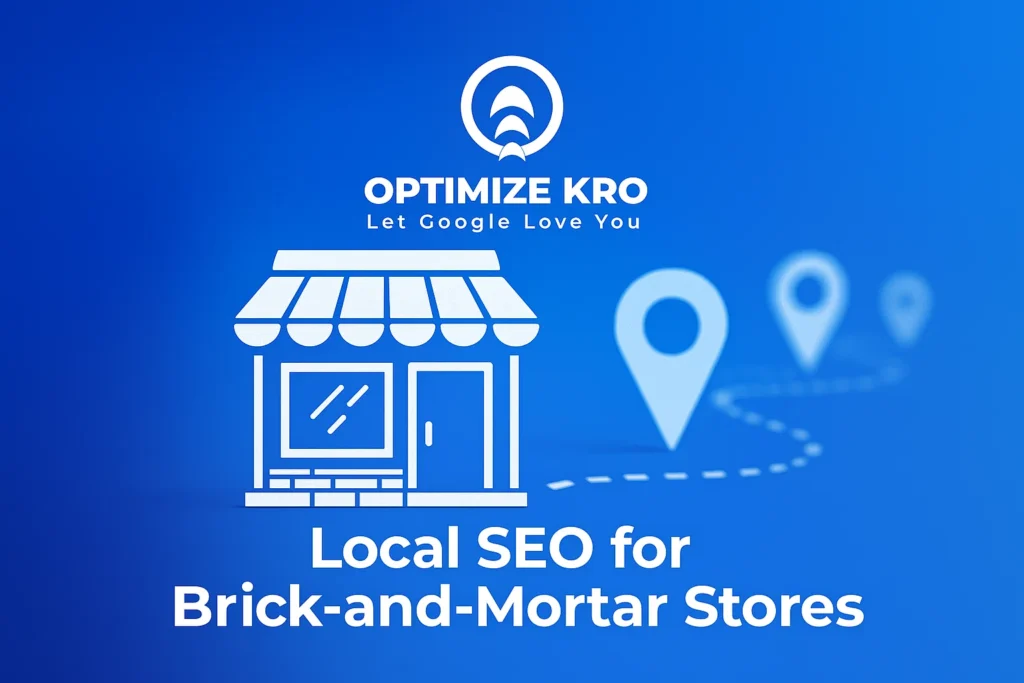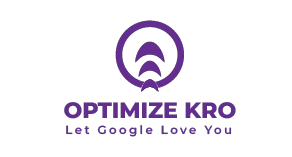In today’s digital age, businesses with physical storefronts can no longer ignore the importance of having a strong online presence. Local SEO (Search Engine Optimization) is crucial for brick-and-mortar stores looking to enhance their visibility, attract more foot traffic, and increase sales. Local SEO helps businesses rank better in local search results, especially on search engines like Google. In this article, we’ll explore how local SEO can benefit brick-and-mortar stores and provide actionable strategies for optimizing your online presence.

What is Local SEO?
Local SEO refers to the practice of optimizing a website to improve its visibility in local search results. Unlike general SEO, which targets global or national search queries, local SEO focuses specifically on location-based search results. This is especially important for brick-and-mortar stores, as most people use search engines to find nearby businesses, products, or services.
For example, if someone searches for “coffee shop near me,” search engines like Google display local businesses in the area. Local SEO ensures that your store shows up in these local searches, making it easier for potential customers to find you.
Why Local SEO Matters for Brick-and-Mortar Stores
Local SEO is incredibly important for businesses with physical locations for several reasons:
1. Increased Online Visibility
Local SEO helps businesses appear in search results when customers search for products or services in their area. By optimizing for local searches, your business can show up in Google’s local pack, Google Maps, and organic search results, improving its overall visibility.
2. Boost in Foot Traffic
The ultimate goal for brick-and-mortar stores is to get customers through the door. Local SEO makes it easier for potential customers to find your location and drives more foot traffic to your business.
3. Higher Conversion Rates
Local searches often have a higher intent to convert. When users search for something like “best pizza in downtown,” they’re typically looking to make a decision soon. By ranking well in these searches, you’re more likely to convert these local users into paying customers.
4. Enhanced Mobile Experience
With the rise of mobile searches, local SEO is more important than ever. Users on smartphones are often looking for nearby businesses in real-time, and optimizing for local SEO ensures your business shows up in these search results.
5. Competitive Advantage
Many businesses still overlook local SEO. By investing in local optimization, you can stay ahead of competitors and dominate your local market.
What Our Clients Say
Trusted by contractors and local businesses for proven Local SEO Services.
John M. – General Contractor
“These guys transformed my Google Maps ranking. More calls, more local leads, and better visibility!”
Sarah L. – Roofing Business
“Within 3 months, my business went from page 3 to the top 3 listings. Highly recommend their Local SEO service!”
David K. – Plumbing Services
“Affordable and effective SEO. My local service calls doubled in less than 90 days.”
Local SEO Strategies for Brick-and-Mortar Stores
Now that we understand why local SEO is important, let’s dive into the strategies you can implement to improve your store’s local visibility.
1. Optimize Google My Business Profile
Google My Business (GMB) is one of the most powerful tools for local SEO. A fully optimized GMB profile can help your business show up in the local pack and Google Maps. Here’s how to optimize your GMB profile:
- Claim and Verify Your Business: If you haven’t claimed your business on Google, start by doing so. Verification can take a few days, but it’s necessary for controlling your business listing.
- Complete All Information: Ensure that your business name, address, phone number, website URL, and business hours are correct. This information should be consistent across all online platforms.
- Add Photos: Include high-quality images of your storefront, products, or services. Photos give potential customers a visual idea of what to expect from your business.
- Use Categories Wisely: Select the most relevant categories for your business. Categories help Google understand what type of business you run and match it with user searches.
- Encourage Reviews: Positive reviews from satisfied customers are a key factor in local rankings. Ask happy customers to leave a review on your GMB page. Respond to reviews to show that you value customer feedback.
2. Optimize for Local Keywords
Using location-specific keywords is essential for local SEO. These keywords help search engines understand the geographical area your business serves. Here’s how to use local keywords effectively:
- Use Location-Specific Keywords: Include your city, neighborhood, or region in your website content. For example, instead of just using “coffee shop,” use “coffee shop in Brooklyn” or “best coffee in Manhattan.”
- Optimize Title Tags and Meta Descriptions: Incorporate local keywords into title tags and meta descriptions. For example, “Top Coffee Shop in Brooklyn – Fresh Brewed Coffee Daily.”
- Use Schema Markup: Schema markup helps search engines understand the content on your website. Implement local business schema markup to highlight important information like your address, phone number, and business hours.
3. Build Local Citations
Citations are mentions of your business online, often in directories or on other websites. These mentions should include your business name, address, and phone number (NAP). Building local citations helps search engines confirm that your business is legitimate and improves your chances of ranking in local searches.
- List Your Business in Local Directories: Submit your business to reputable local directories like Yelp, Yellow Pages, and Chamber of Commerce websites.
- Consistency is Key: Ensure that your NAP (Name, Address, Phone number) is consistent across all platforms. Inaccurate or inconsistent information can hurt your local rankings.
- Leverage Industry-Specific Directories: Depending on your business type, industry-specific directories might also provide valuable citations.
4. Improve On-Page SEO
On-page SEO refers to optimizing the content and structure of your website. Here are key on-page SEO strategies for local SEO:
- Optimize Your Homepage: Ensure your homepage includes local keywords and mentions your location prominently.
- Create Location-Based Landing Pages: If your business has multiple locations, create separate landing pages for each location. These pages should include unique content tailored to the local audience.
- Include Contact Information on Every Page: Make it easy for customers to contact you. Include your address, phone number, and a contact form on every page of your website.
5. Mobile Optimization
Since most local searches are conducted on mobile devices, having a mobile-friendly website is crucial for local SEO. A mobile-optimized website provides a better user experience and helps improve your rankings in mobile search results.
- Ensure Fast Loading Times: Slow websites can negatively affect both user experience and search rankings. Use tools like Google PageSpeed Insights to identify areas for improvement.
- Responsive Design: Make sure your website adapts to different screen sizes. A responsive design ensures that your site is easy to navigate on mobile devices.
- Easy-to-Use Navigation: Simplify navigation and make it easy for users to find key information like your location, contact details, and hours of operation.
6. Local Link Building
Building backlinks from local websites can significantly improve your local SEO. The more relevant and authoritative links your site has, the higher it will rank in local searches.
- Partner with Local Businesses: Collaborate with local businesses or organizations for mutual link-building opportunities.
- Sponsor Local Events or Causes: Sponsorships can help you gain backlinks from local news websites, event pages, or community organizations.
- Create Local Content: Publishing content relevant to your local area can attract links from local blogs and news outlets.
7. Leverage Social Media
Social media platforms like Facebook, Instagram, and Twitter can help drive local engagement and improve your local SEO efforts.
- Claim Your Social Media Profiles: Ensure your business is listed on major social platforms and that your NAP information is consistent.
- Engage with Local Audiences: Post content relevant to your local community, including local events, news, and promotions.
- Use Location Tags: When posting on social media, use location tags to increase the chances of being discovered by local users.
Local SEO FAQ for Brick-and-Mortar Stores
1. How long does it take to see results from local SEO?
Local SEO can take anywhere from a few weeks to a few months to show significant results. However, the effort is worth it, as local SEO provides long-term visibility and sustainable growth.
2. What is the best way to get reviews for my business?
Ask your satisfied customers for reviews via email, social media, or in person. Make it easy for them by providing direct links to your Google My Business or Yelp profile.
3. Should I use paid ads for local SEO?
While local SEO can be incredibly effective on its own, paid ads (like Google Ads) can help boost your visibility in local searches. Consider combining both strategies for maximum impact.
4. How do I optimize my business for voice search?
Voice search often focuses on natural language and local queries. Use conversational keywords in your content, such as “Where can I find the best pizza in [city]?”
5. Do I need to focus on local SEO if my business is new?
Yes, local SEO is crucial for new businesses to build their online presence. It can help you gain traction and attract local customers quickly.
Conclusion
Local SEO is a powerful tool for brick-and-mortar stores looking to attract more customers and increase sales. By optimizing your Google My Business profile, using local keywords, building citations, improving on-page SEO, and engaging in local link building, you can significantly boost your online visibility and drive more foot traffic to your store.
Remember that local SEO is a long-term strategy, but the results are well worth the effort. Start implementing these strategies today, and you’ll be well on your way to dominating your local market.
Table: Key Elements of Local SEO
| Element | Strategy | Benefits |
|---|---|---|
| Google My Business | Claim and optimize your GMB profile | Increased visibility in local searches |
| Keywords | Use location-based keywords in content | Improved search rankings |
| Local Citations | Build consistent NAP listings across directories | Enhanced online presence |
| On-Page SEO | Optimize title tags, meta descriptions, and content | Better user experience and rankings |
| Mobile Optimization | Ensure your website is mobile-friendly | Improved mobile search results |
| Link Building | Build backlinks from local sources | Increased authority and rankings |

Gulfam Qamar is a seasoned Local SEO expert with a proven track record of helping businesses boost their online visibility and dominate local search results. With deep expertise in Google Business Profiles, on-page optimization, and local citation strategies, Gulfam helps brands connect with nearby customers and grow sustainably. When he’s not optimizing websites, he’s sharing actionable SEO tips and insights to empower small businesses in the digital space.

